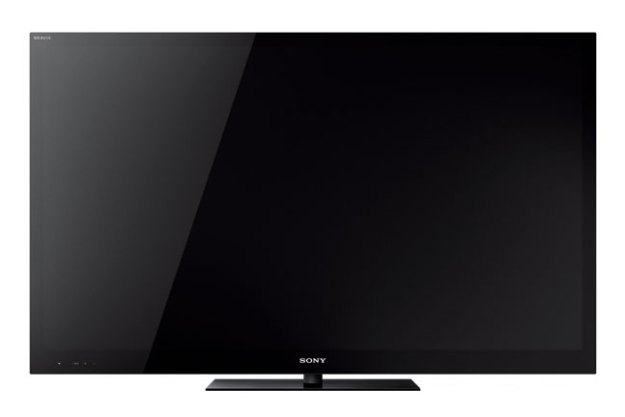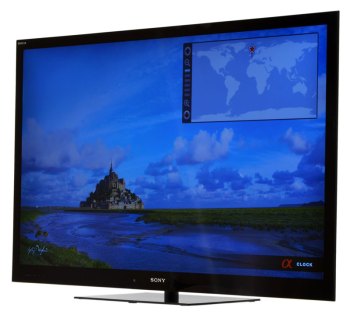
“We don’t wish to take anything away from the Sony's XBR line, but the fact is the NX720 is a better over-all value and that is why we’re stamping it with our Editor’s Choice award.”
- Excellent black level and contrast
- Very bright white levels
- Slick, flat panel with darkened, anti-glare glass
- Built-in Wi-Fi, plenty of Internet apps
- Quick network media access
- 3D glasses not included
- Remote not backlit
Sony NX720 series information: This review is based on our hands-on experience with the 55-inch KDL-55NX720 TV. However, our observations also apply to the two other sizes in Sony’s NX720 series of LED TVs, including the 46-inch KDL-46NX720 and 60-inch KDL-60NX720. According to Sony, the three sets have identical specifications (save dimensions and weight) and should offer similar performance.
|
Models in Sony’s NX720 series |
Size |
| Sony KDL-46NX720 | 46 inches |
| Sony KDL-55NX720 (reviewed) | 55 inches |
| Sony KDL-60NX720 | 60 inches |
We just recently reviewed Sony’s top-of-the-line XBR-HX929 series television, and concluded it was one of the best (if not the best) looking LCD displays we’ve ever tested. Then, just a few short weeks later, Sony sent us this 55-inch version of its KDL-NX720 series, which while larger than the 46-inch XBR we tested, is two steps down in Sony’s line-up. The question running through our minds: How would it compete against Sony’s flagship model?
We ran the 55NX720 through our gauntlet of tests, scrutinized the differences between it and Sony’s flagship series and, as it turns out, this display did very well. In this review we discuss the performance of this set, consider its place in Sony’s TV line-up and offer up our opinion as to whether the well regarded XBR-HX929 series is worth the extra bucks.
Out of the box
As we pulled the KDL-55NX720 3D LED backlit TV from its box, we noticed it bore a strong resemblance to the 46-inch XBR. Like the XBR, this model features Sony’s “monolithic” design with an all-but-invisible bezel tucked beneath a layer of Gorilla Glass — it’s a gorgeous TV. This model measures in at 50.5 x 30.5 x 1.3 inches, making it ever-so-slightly taller and wider than the 55-inch XBR version, yet a bit shallower due to the fact that the NX720 doesn’t have the clumsy RS-232 box tacked onto its rear panel. Considering the similar measurements, we were surprised to see that the NX720 weighs 6.6 pounds less than the XBR model. Since a good deal of the set’s weight probably comes from the Gorilla Glass panel, we have to wonder what’s going on inside the TV that would account for the weight difference.

Along with the TV, we found the display’s table-top stand, a dongle for component video and composite AV cables, user manual, remote and batteries. As we prepared to attach the stand to the back of the TV, we noticed it was secured a bit differently than with the 46-inch XBR we tested. Here, the NX720 offers two additional screws for the stand’s slots to slide over and lock onto. From there, three security screws finish the assembly. We felt this design made the TV feel a bit more stable and secure on its stand.
Features and design
As we alluded to earlier, the NX720’s outward appearance is almost identical to the XBR series. The front side is extremely clean, with just a power LED on the lower left, a Bravia logo on the upper left and Sony’s illuminated (and dimmable) badge breaking up an otherwise jet-black surface. The back of the display appears to be exactly the same as the XBR, save the welcome absence of the RS-232 box. We found two USB ports, four HDMI inputs (one with audio return channel, or ARC), PC video and audio inputs, coaxial cable input, Ethernet jack, optical digital audio output, headphone output and a space to connect the provided dongle with component video and composite jacks. While NX720 may not offer RS-232 connectivity for high-end custom integration, we think many will be pleased with the NX720’s slimmer profile.

It is under the hood that we find most of the defining differences between this set and its XBR counterpart. Most of it comes down to processing features. The NX720 is an edge-lit TV with local dimming, whereas the XBR offers full array local dimming. The NX720 uses a 120Hz panel, whereas the XBR uses a 240Hz panel, therefore the NX720 offers “Motionflow XR 240” rather than the “Motionflow XR 960” found in the XBR. The NX720 also features Sony’s XReality engine rather than the XReality PRO and, with the NX720 there’s no IR input. Still with us?
The remote control for the NX720 may look identical to the XBR remote but there’s one critical component missing: backlighting. We just don’t understand why it is that something as simple and inexpensive as a LED backlighting isn’t incorportated into every new remote control on the planet by now. People watch TV in the dark…please give us a light in the stinkin’ remote, ok?
Most of the NX720’s remaining features appear to match the XBR. You still get the intelligent presence sensor (no face recognition, though), which can customize the picture by detecting viewers and their positions in the room. You still get the full suite of Internet widgets, DLNA capability, Internet media access through all the same providers (Netflix, Hulu Plus, YouTube etc.) and the graphic user interface appears to be exactly the same as well.
Now, let’s talk about what all those differences end up meaning in terms of performance:
 Performance
Performance
To test the NX720 we connected a Sony 1700ES Blu-ray player, Xbox 360, Marantz SR6005 and an HD antenna for some terrestrial HD reception. For video content, we chose the 2D version of Avatar on Blu-ray, the 3D version of Cloudy with a Chance of Meatballs and Rio in 2D on Blu-ray.. We also spent more than the usual amount of time streaming YouTube and Netflix videos. More on that later.
Before we ran any test patterns, we selected Sony’s “custom” picture pre-set (standard and vivid are also available) and grinned to ourselves as every single supplementary processor was turned off automatically. It might as well have been called “purist” mode. (In our TV calibration guide, we talk about why it is important to disable various processors when calibrating a TV.)
We then ran through the Spears & Munsil test patterns and, as we progressed, were taken aback at how little adjustment needed to be made. The backlight setting was on the money, as was the brightness setting (that was a shocker). In fact, when all was said and done, all we had to do to get this set meeting spec was back the contrast/picture setting down from 100 to 85. We also found color temperature was more accurate with the “Warm 2” preset, but opted for “Warm 1” out of personal preference.
Interestingly, our experience with the XBR required a bit more adjustment and, as we recall, the chroma burst pattern never did come around to looking exactly right, whereas the NX720 rendered it beautifully. Of course, one of the other defining differences between the two series is that the XBR offers more advanced controls over the picture settings. More options often translates into more opportunity to unintentionally screw something up, so that may partially explain why it is that the NX720 was so much easier to work with.

Everything else we look for was excellent. Color hue and saturation were terrific, motion looked natural with minimal blur, artifacts and judder and we felt like the NX720 offered fantastic depth to the images we were viewing. Even the speakers built into the TV didn’t sound all that bad.
We switched over to the Sony’s media apps and brought up YouTube. We typically pop into a TV’s YouTube app just to see how good (or terrible) the interface is but, in this case, we wanted to try to judge the NX720’s X-Reality engine versus the XBR’s X-Reality Pro engine. According to Sony, X-Reality Pro is better because it analyzes the frame just before and after the active frame to create a better looking image with more detail and fewer artifacts. X-Reality is more simplified, and just works with the image at hand.
While this sort of technology isn’t necessary with high-bitrate material, the stuff we see on YouTube is generally low-bitrate stuff and, therefore, super pixelated and just generally not fun to watch on a large, high-definition screen. X-Reality aims to fix it all up and make it look better.
Considering we were looking at a 55-inch screen displaying video of marginal quality, we thought the Xreality tech did a decent job. Is the Pro version considerably better? We’re not so sure, and not convinced it matters much either. We just can’t see a lot of people spending nearly $3,000 on a TV so they can watch crappy video sources like YouTube (no offense, YouTubers).
As for 3D: Yeah, it works. To be frank, we just haven’t jumped on the active 3D bandwagon yet. The glasses, while significantly more comfortable than most of the passive 3D glasses we’ve tried, are still pricey, require batteries or battery charging and flicker in a way that makes us want to take them off. On this particular set, it’s also important to note they aren’t included, so you’ll need to pick them up separately at $70 a pair.

Do expect to have to re-do some picture adjustments in 3D mode, though. The TV will max out the backlight and prohibit adjustments. The contrast setting will also be maxed out and, by default, local dimming is turned off, but can be turned back on again.
Conclusion
You may have noticed that we’ve gone out of our way in this review to highlight the differences between the NX720 and its XBR counterpart. Here’s why: The NX720 is such an outstanding television that we think it will be the better choice for many buyers. It’s easier to set up, it’s local dimming does a terrific job, it’s slimmer, looks fantastic and, best of all, it’s less expensive. For most folks, the NX720 will do 97 percent of what the XBR could offer them, and the 3 percent that’s left is probably not worth dickering over. We don’t wish to take anything away from the XBR, but the fact is the NX720 is a better over-all value and that is why we’re stamping it with our Editor’s Choice award.
Highs:
- Excellent black level and contrast
- Very bright white levels
- Slick, flat panel with darkened, anti-glare glass
- Built-in Wi-Fi, plenty of Internet apps
- Quick network media access
Lows:
- 3D glasses not included
- Remote not backlit





